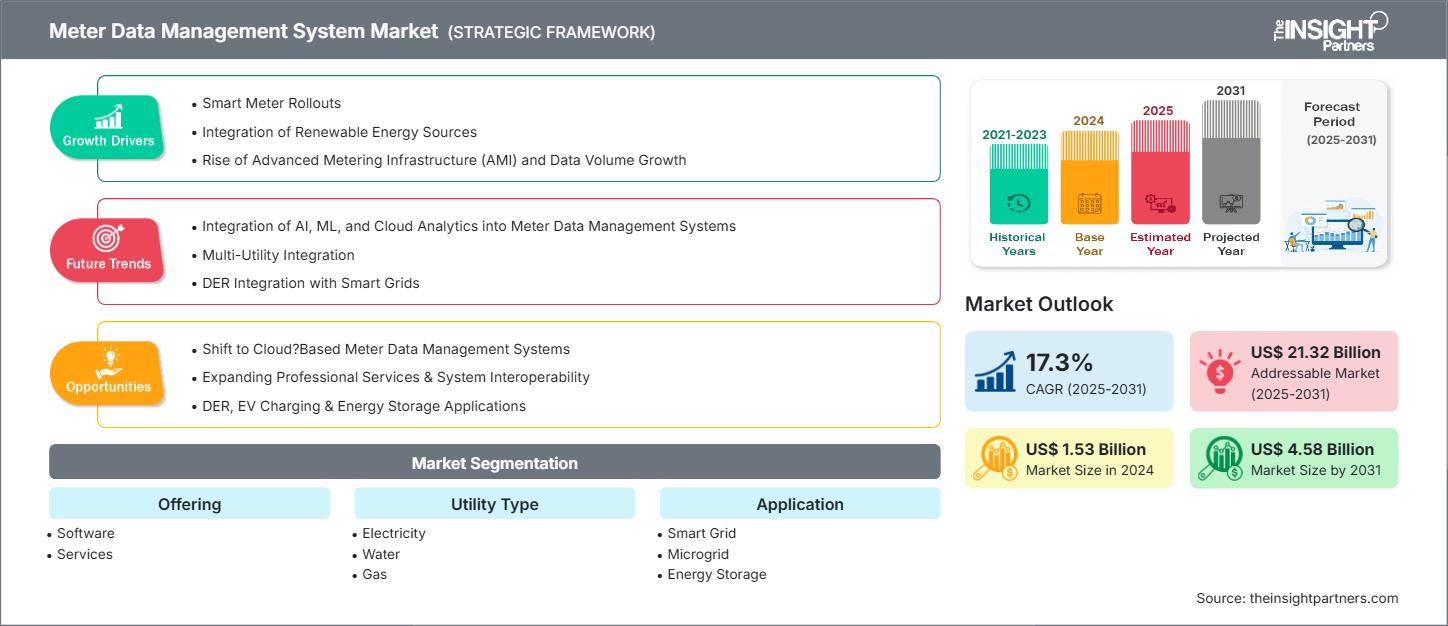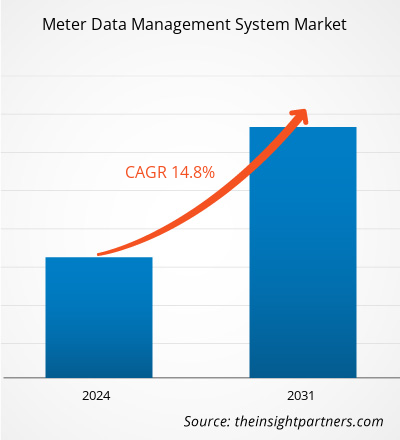预计到 2031 年,仪表数据管理系统市场规模将从 2024 年的 15.3 亿美元增至 45.8 亿美元。预计 2025-2031 年期间该市场的复合年增长率为 17.3%。
仪表数据管理系统市场分析
全球电表数据管理系统市场增长背后有几个关键因素,例如智能电表的广泛部署、清洁能源的整合、先进计量基础设施 (AMI) 的兴起、数据量的增加以及政府的举措。在向云端电表数据管理解决方案的过渡以及能源可持续性持续投入的推动下,市场在预测期内有望继续增长。影响市场的一个重要趋势是基于人工智能的电表数据管理解决方案的兴起。然而,诸如计量数据波动等问题可能会减缓市场扩张。
仪表数据管理系统市场概况
对于电力、天然气、水利和热力等公用事业企业而言,电表数据管理系统 (MDMS) 依然必不可少。此类系统能够收集、验证和管理来自客户场所的电表数据。所收集的数据是各种活动的基础,包括计费、客户服务、能耗预测、运营监控(例如,停电检测和损耗分析)以及财务报告。此外,除了公用事业行业之外,能源服务公司也使用电表数据管理系统解决方案进行审计和节能项目;能源管理公司使用其进行能耗报告和分析;独立能源生产商和本地能源供应商使用其进行生产规划和工程设计;工商企业则使用其进行内部会计和财务管理。市政当局和政府机构也在公共基础设施项目和法规合规工作中使用这些系统。
您可以免费定制任何报告,包括本报告的部分内容、国家级分析、Excel 数据包,以及为初创企业和大学提供优惠和折扣
仪表数据管理系统市场:战略洞察

-
获取此报告的顶级关键市场趋势。此免费样品将包括数据分析,从市场趋势到估计和预测。
仪表数据管理系统市场驱动因素和机遇
市场驱动因素:
-
智能电表的推出:
电表数据管理系统市场背后的主要原因之一是全球范围内大规模部署智能电表,这是各国政府为响应监管需求和基础设施现代化而实施的。 -
可再生能源的整合:
电表数据管理系统平台在当今能源领域正变得越来越不可或缺。本质上,它们就像一个地理信息系统 (GIS) 地图软件,用于捕获、验证、汇总和分析智能计量基础设施 (AMI) 读数的四维(x、y、z 和时间)数据。GIS) mapping software that captures, validates, aggregates, and analyzes four-dimensional (x, y, z and time) data of smart metering infrastructure (AMI) readings. -
高级计量基础设施(AMI)的兴起和数据量的增长:AMI) and Data Volume Growth:
影响全球计量数据管理系统市场的主要因素之一是先进计量基础设施 (AMI) 的快速部署。AMI).
市场机会:
-
基于云的部署扩展:
云基础设施的使用日益增多,为公用事业提供了可扩展且更经济实惠的 MDMS 解决方案,这在很大程度上是由基于云的部署需求驱动的。 -
扩展专业服务和系统互操作性:
MDMS 基础设施日益复杂是导致咨询、集成和维护服务需求不断增长的主要原因,尤其侧重于客户信息系统的集成和 DER 的管理。 -
DER、EV充电和储能应用:
微电网、电动汽车充电和储能的出现为专用 MDMS 模块和定制解决方案的开发开辟了新的途径。
仪表数据管理系统市场报告细分分析
为了更清晰地了解电表数据管理系统市场运作方式、增长潜力和最新趋势,我们将市场细分为不同的细分领域。以下是大多数行业报告中使用的标准细分方法:
通过提供:
-
软件:
电表数据管理系统的软件组件是智能公用事业收集、存储、处理和分析智能电表产生的大量数据的主要核心。 -
服务:
与电表数据管理系统相关的服务涵盖确保其成功部署和生命周期管理所需的各种产品。这些服务包括部署前的活动,例如需求分析、咨询和架构设计,以及随后的系统集成、测试和部署。
按实用程序类型:
-
电:
电力公司在电表数据管理系统市场占据主导地位,主要是因为智能电表的大规模推广。 -
水:
水表数据管理系统 (MDMS) 的供水部分正在扩展,以允许公用事业公司更新其面临缺水、泄漏和非收入水 (NRW) 等各种问题的旧基础设施。 -
气体:
天然气行业的 MDMS 有助于确保安全、准确计费并满足监管机构的要求。智能燃气表提供系统安全高效运行所需的消耗数据、流量和压力水平。
按应用:
-
智能电网:
智能电网应用领域是电表数据管理系统的主要和最成熟的用例。 -
微电网:
微电网是独立运行或与主公用电网协同运行的本地化电网。 -
储能:
电表数据管理系统有助于精确跟踪电池充电/放电周期、能量吞吐量、健康状态 (SoH) 和电网信号集成。 -
电动汽车充电:
电动汽车(EV)充电给电网运营商带来了新的挑战和机遇。 -
其他的:
仪表数据管理系统的其他应用正在建筑能源管理、区域供热、点对点能源交易和能源效率计划等领域出现。
按最终用户行业:
- 住宅
- 商业的
- 工业的
每个行业都有特定的仪表数据管理系统要求,这会影响数据管理和分析。
按地域划分:
- 北美
- 欧洲
- 亚太地区
- 南美洲和中美洲
- 中东和非洲
亚太地区的电表数据管理系统市场预计将出现最快的增长。可再生能源的整合和先进计量技术的兴起可能会推动市场的发展。
仪表数据管理系统市场区域洞察
Insight Partners 的分析师已详尽阐述了预测期内影响计量数据管理系统市场的区域趋势和因素。本节还讨论了北美、欧洲、亚太地区、中东和非洲以及南美和中美洲的计量数据管理系统市场细分和地域分布。
仪表数据管理系统市场报告范围
| 报告属性 | 细节 |
|---|---|
| 2024年的市场规模 | 15.3亿美元 |
| 2031年的市场规模 | 45.8亿美元 |
| 全球复合年增长率(2025-2031) | 17.3% |
| 史料 | 2021-2023 |
| 预测期 | 2025-2031 |
| 涵盖的领域 |
通过提供
|
| 覆盖地区和国家 |
北美
|
| 市场领导者和主要公司简介 |
|
仪表数据管理系统市场参与者密度:了解其对业务动态的影响
电表数据管理系统市场正在快速增长,这得益于终端用户需求的不断增长,而这些需求的驱动因素包括消费者偏好的不断变化、技术进步以及对产品优势的认知度不断提高。随着需求的增长,企业正在扩展产品线,不断创新以满足消费者需求,并抓住新兴趋势,从而进一步推动市场增长。

- 获取仪表数据管理系统市场顶级关键参与者概览
电表数据管理系统市场份额(按地区)分析
预计未来几年亚太地区市场将增长最快。南美、中美以及中东和非洲等新兴市场也为电表数据管理系统供应商提供了许多尚未开发的扩张机会。
电表数据管理系统市场因地区而异。不同的区域增长模式受到智能电表的实施、可再生能源的使用以及高级计量基础设施 (AMI) 和数据量的增加等因素的影响。以下是不同地区的市场份额和趋势概述:
1. 北美
-
市场份额:
由于早期采用和公用事业现代化而占据主导地位 -
关键驱动因素:
- 智能电网投资
- 联邦和州级能源效率规定
- 智能电表普及率高
-
趋势:
将 MDMS 与分布式能源资源管理系统 (DERMS) 集成,实现实时电网平衡
2.欧洲
-
市场份额:
严格的能源法规和可持续发展目标推动了很大一部分 -
关键驱动因素:
- 欧盟能源效率指令
- 可再生能源整合
- 支持跨境能源数据平台
-
趋势:
基于云的 MDMS 的增长与欧盟的数字化转型框架保持一致
3. 亚太地区
-
市场份额:
增长最快的地区,大力推行智能电网举措 -
关键驱动因素:
- 政府主导的数字公用事业计划
- 城市化和智慧城市发展
- 电网可靠性问题
-
趋势:
支持人工智能的 MDMS 激增,用于管理大量数据和需求预测
4.南美洲和中美洲
-
市场份额:
新兴市场对公用事业现代化的投资不断增加 -
关键驱动因素:
- 老化基础设施升级
- 偏远地区电气化
- 区域可再生能源项目
-
趋势:
优先选择模块化MDMS平台,以适应智能电表的逐步普及
5.中东和非洲
-
市场份额:
政府强力支持,市场不断增长 -
关键驱动因素:
- 国家能源多元化计划
- 水能联结项目
- 智慧城市和公用事业改革
-
趋势:
在传统能源和可再生能源混合电网中部署MDMS
仪表数据管理系统市场参与者密度:了解其对业务动态的影响
市场密度高,竞争激烈
由于甲骨文、西门子、Itron、兰吉尔和施耐德电气等主要供应商的加入,竞争愈演愈烈。卡姆鲁普(欧洲)、Aclara(北美)和威胜集团(亚洲)等区域性和利基市场参与者也加剧了市场竞争。
这种竞争环境促使供应商通过以下方式实现差异化:
- 与智能电网和可再生能源系统的整合
- 可扩展的云原生 MDMS 平台
- 用于负载预测和故障检测的人工智能驱动数据分析
- 与多供应商电表生态系统的互操作性
机遇与战略举措
- 与公用事业公司和政府合作在全国范围内推广智能电表
- 嵌入 AI/ML 以增强预测性维护和消费分析
在仪表数据管理系统市场运营的主要公司有:
- Itron Inc.——美国
- 甲骨文公司 – 美国
- Gentrack集团——新西兰
- Fluentgrid Limited——印度
- 西门子股份公司——德国
- Landis+Gyr Group AG——瑞士
- 霍尼韦尔国际公司 - 美国
- Hubbell Inc – 美国
- ABB有限公司——瑞士
- AVEVA Group Plc – 英国
免责声明:以上列出的公司没有按照任何特定顺序排列。
研究过程中分析的其他公司:
- 斑杜鹃
- Smartflex
- Connexo 洞察
- ATLAS 能源监控系统
- PI 系统 (AVEVA)
- Net@Suite(信息工程工程师)
- Terranova TAMM MDM
- Ferranti MECOMS
- Energyworx
- 树液
- Meddata 解决方案
- Radix 物联网
- 能源CAP
- 霍尼韦尔EI服务器
- 伊顿
仪表数据管理系统市场新闻和最新发展
-
Esyasoft 宣布与 Adani Energy 成立合资企业
Esyasoft 宣布与 Adani Energy Solutions 成立合资企业,在印度及其他国家实施智能计量项目。此次合作涉及 Adani 收购 Esyasoft 智能计量解决方案部门 49% 的股份。 -
Landis+Gyr 宣布已完成 MDUS 认证
Landis+Gyr 宣布已完成 Landis+Gyr MDMS 平台的 MDUS 认证。此认证的更新使使用 MDUS 集成服务的公用事业客户能够访问新的间隔和时间序列计费功能。Landis+Gyr 的 MDUS(计量数据统一和同步)是一款独特的解决方案,通过将智能计量环境连接并同步到公用事业后台系统,实现端到端业务流程。
仪表数据管理系统市场报告覆盖范围和交付成果
《仪表数据管理系统市场规模和预测(2021-2031)》报告对以下领域进行了详细的市场分析:
- 仪表数据管理系统市场规模以及全球、区域和国家层面涵盖的所有关键细分市场的预测
- 仪表数据管理系统市场趋势以及市场动态,例如驱动因素、限制因素和关键机遇
- 详细的 PEST 和 SWOT 分析
- 仪表数据管理系统市场分析涵盖主要市场趋势、全球和区域框架、主要参与者、法规和最新市场发展
- 行业格局和竞争分析,涵盖市场集中度、热图分析、知名参与者以及仪表数据管理系统市场的最新发展
- 详细的公司简介
- 历史分析(2 年)、基准年、预测(7 年)及复合年增长率
- PEST和SWOT分析
- 市场规模、价值/数量 - 全球、区域、国家
- 行业和竞争格局
- Excel 数据集
近期报告
相关报告
客户评价
购买理由
- 明智的决策
- 了解市场动态
- 竞争分析
- 客户洞察
- 市场预测
- 风险规避
- 战略规划
- 投资论证
- 识别新兴市场
- 优化营销策略
- 提升运营效率
- 顺应监管趋势






















 获取免费样品 - 仪表数据管理系统市场
获取免费样品 - 仪表数据管理系统市场